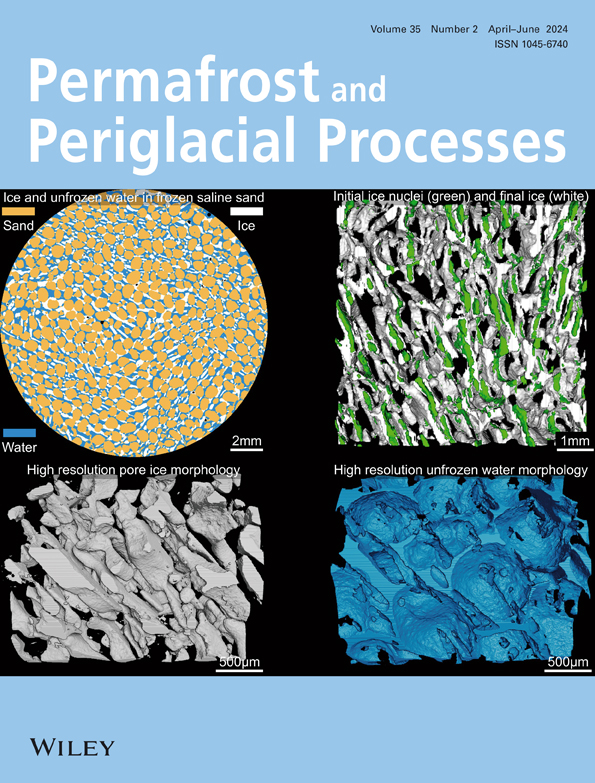Multi‐stage evolution of frost‐induced microtextures on the surface of quartz grains—An experimental study
IF 3.3
3区 地球科学
Q2 GEOGRAPHY, PHYSICAL
引用次数: 3
Abstract
Coarse sand‐sized (0.5–1.0 mm) grains of vein quartz were subjected to frost‐induced stress under controlled laboratory conditions. A total of 1,000 freeze–thaw (FT) cycles, simulated under different (low, high) water mineralization conditions in the temperature range from −5°C up to +10°C, were used to test effects on collected samples. Scanning electron microscopic (SEM) microtextural analysis of grain surfaces was performed at 0 (start) and after 50, 100, 300, 700, and 1,000 FT cycles. The results indicate that variable frost‐induced microtextural imprints encountered on quartz grain surfaces prior to and following analysis depend largely on the mineralization (dissolved solute content) of water involved in the weathering process. The higher the water mineralization, the greater the intensity of mechanical weathering. Two predominant outcomes in the course of these micro‐scale frost weathering tests have been identified: a physical (mechanical) aspect manifested by the occurrence of conchoidal fractures and breakage block microtextures dominating up to 300 FT cycles, and a chemical aspect resulting in the occurrence of precipitation crusts and obliteration of grain microrelief. Moreover, three additional stages of microtexture development may be distinguished with the evolution of frost‐induced microrelief on the surface of quartz grains: (i) initial cracks of large‐sized conchoidal fractures, (ii) increasing frost cycles yielding additional small‐sized conchoidal fractures, and (iii) advanced breakage blocks. Frost‐induced exposure of fresh, unweathered grain surfaces leads to refreshing of the grain surface.石英晶粒表面霜致微织构的多阶段演化实验研究
在受控的实验室条件下,粗砂级(0.5-1.0 mm)脉状石英颗粒受到霜致应力的影响。在−5°C至+10°C的温度范围内,模拟不同(低、高)水矿化条件下的1000次冻融(FT)循环,以测试对所收集样品的影响。在0(开始)和50、100、300、700和1000 FT循环后,对晶粒表面进行扫描电镜(SEM)微观结构分析。结果表明,在分析之前和之后,石英颗粒表面上的可变霜致微纹理印记在很大程度上取决于风化过程中涉及的水的矿化(溶解溶质含量)。水矿化程度越高,机械风化强度越大。在这些微尺度霜冻风化试验过程中,已经确定了两个主要结果:物理(机械)方面表现为贝壳状裂缝和破碎块微织体的出现,占300 FT旋回的主导地位;化学方面表现为降水结壳的出现和颗粒微地形的消失。此外,霜冻诱发的石英颗粒表面微起伏的演化还可以区分出三个额外的微观结构发展阶段:(i)大尺寸贝壳状裂缝的初始裂缝,(ii)霜冻循环增加产生额外的小尺寸贝壳状裂缝,以及(iii)晚期破碎块。霜冻引起的新鲜、未风化的谷物表面暴露导致谷物表面的清爽。
本文章由计算机程序翻译,如有差异,请以英文原文为准。
求助全文
约1分钟内获得全文
求助全文
来源期刊
CiteScore
9.70
自引率
8.00%
发文量
43
审稿时长
>12 weeks
期刊介绍:
Permafrost and Periglacial Processes is an international journal dedicated to the rapid publication of scientific and technical papers concerned with earth surface cryogenic processes, landforms and sediments present in a variety of (Sub) Arctic, Antarctic and High Mountain environments. It provides an efficient vehicle of communication amongst those with an interest in the cold, non-glacial geosciences. The focus is on (1) original research based on geomorphological, hydrological, sedimentological, geotechnical and engineering aspects of these areas and (2) original research carried out upon relict features where the objective has been to reconstruct the nature of the processes and/or palaeoenvironments which gave rise to these features, as opposed to purely stratigraphical considerations. The journal also publishes short communications, reviews, discussions and book reviews. The high scientific standard, interdisciplinary character and worldwide representation of PPP are maintained by regional editorial support and a rigorous refereeing system.

 求助内容:
求助内容: 应助结果提醒方式:
应助结果提醒方式:


